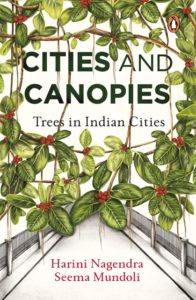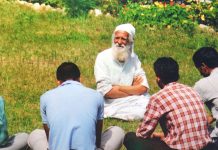One of the most important concerns that you have raised throughout your academic writings is about how communities can contribute to ecological imbalance and at the same time communities can help in nurturing the environment too. What role do you think the intersection of academics and field-action play in addressing the concerns?
Academics and action are closely intertwined, especially in domains like ecology, education and development. Elinor Ostrom is a hugely influential figure whose work shows us a way forward. Ostrom’s Nobel prize-winning work demonstrated that communities can be a powerful force for collective action and environmental protection in diverse parts of the world, and in a range of contexts including coastal environments, forests, cities and agricultural systems. Her work was and is highly influential in the academic community, inspiring new research in fields as varied as evolutionary biology, game theory, political science and economics. At the same time, her research played a major role in informing communities and civic groups engaged in collective action. The International Association for Study of the Commons, which she helped to found, nurtured academics and practitioners alike. We need similar intersectional areas where ecologists and field practitioners can engage, and learn from each other. Ecological science needs to be as informed by practice, as practice can be by science.
How do you approach the concept of cities as socio-ecological systems and why do you think looking at urban spaces as sites for environmental concerns is significant for addressing environmental issues of our times?
Cities are often thought of as purely social-economic systems – but they are very strongly coupled social-ecological systems. As the various stories in Cities and Canopies: Trees in Indian Cities show, Indian cities have been fundamentally shaped for centuries by the nature of the ecological landscapes in which they are embedded. Coastal cities like Mumbai and Chennai have specific patterns of growth, shaped around their wetlands and mangroves. The culture of these cities is built around the coastline, which forms a huge public space where citizens from all walks of life mingle together. Arid interior cities like Bengaluru, Hyderabad and Jodhpur have grown very differently – they do not have such large public spaces, but have parks and remnant patches of wilderness, into which people squeeze in large numbers.
Apart from the larger landscape, local environmental features also play a major role in shaping everyday life. Our interviews with street vendors in Bengaluru and Hyderabad show that the cutting of trees (for instance for the Metro) leads to gentrification. When the trees are cut, the customers move out to more shaded, liveable areas, and the vendors disappear. Land prices rise, and malls move into the neighborhood. Eventually, the slums are razed down, and the poorer residents forcibly relocated to outside the city. Urban diseases like dengue and swine flu and health disorders like diabetes and asthma are also closely linked to waste disposal, polluted water and air, and lack of green cover. So we cannot address many social and economic issues without paying close attention to urban environments and ecologies.
We see the proliferation of cities around the globe that have unsustainable relationships with the environment- they often lack adequate green cover, adequate water resources, locally produced food items and a general incapacity to tackle natural calamities like earthquakes or floods. Please tell us about the importance of thinking ecologically about cities?
Your question itself defines the importance very well! We are always puzzled by people (seemingly the urban majority) who think that the first priority is development, and environmental protection can come second. This is impossible in practice. If we cut down all our trees and uproot all plants in the city – where will our oxygen come from? How will we breathe? If we destroy our lakes and rivers in our haste to grab all available land for construction, where will our water come from? We cannot continue to import water from distant rivers, as our drying cities show us. Bengaluru and Delhi governments are cutting hundreds of trees for roads and infrastructure, and then planning to install giant air filters to clean the polluted air. This is illogical thinking at its best. Even today, when you read any newspaper article on citizen protests about tree felling, you will see responses by readers that essentially conflate these protests with an “anti-development” focus. These commenters ask the protestors to plant new trees and allow the existing trees to be cut. But new trees need 10-20 years to grow and provide benefits, and they need water and appropriate temperature to survive – these conditions are fast disappearing. We cannot have development without ecology, especially in our cities.
How do we cultivate a citizenry that thinks ecologically? How can we integrate the research on ecology with concrete transformation at the grassroots? Where do you think our education system lacks and what will your suggestions be for the same?
Children naturally think ecologically. The inspiring action of Greta Thunberg and the hundreds of thousands of school children, who have gathered with her to protest against climate change across the world, shows us this. It is us adults who are too steeped in supposedly pragmatic ways of thinking, who have lost the awareness of the need to think ecologically. We need education to move away from a solely-textbook and marks-focused pedagogy to encouraging children to get engaged with nature, hands-on. And we also need education for parents, to encourage them to take their kids out for nature walks every weekend, examining trees, leaves and flowers, learning to identify birds and insects, and to feel, smell and taste nature with all senses alive. We love hearing from readers of Cities and Canopies who have returned from such walks, who are beginning to write in with their tales of what they found!
What according to you are the major ecological challenges that face India and how well equipped do you think we are as a nation to tackle those?

The most issue, literally a burning challenge for us, is the climate crisis. Climate change is already making its impacts felt across India, as the recent effects of Cyclone Fani indicate. The country will face challenges of severe water shortage due to melting ice caps and glaciers and erratic rainfall; coastal flooding will displace tens of millions and lead to forced migration; and heat waves will impact longevity and productivity. The health impacts of climate change are unknown but sure to be devastating. Other environmental crises – air pollution and the challenge of plastic waste, for instance – are also mounting, and we seem very ill equipped to tackle them. What we need is systemic changes – in the way we produce and dispose waste, in the way we manage mobility and transport, and produce energy. However, most public and media discussions focus on individual action – urging us to compost, take cloth bags for shopping, use public transport. While well meaning, this does not tackle the bigger issue of systemic changes in policies and market economics. We need to increase public awareness and create a public movement that pushes businesses and Governments to act, in all urgency.
What are the ways in which each one of us can contribute to building the ecological consciousness?
The most important way is to invest in community building. As the influence of the growing student movement against climate change shows us, our greatest influence is as collectives. The #FridayforFuture climate strikes by children have inspired the UK, Ireland and Catalonia to declare climate emergencies. At a more local scale, resident groups have got together across Indian cities to host tree and bird walks, plantation drives, and lake clean-up activities. The spillover of such group activities is tremendous – it creates a strong sense of community, and builds social capital, which enables these groups to then tackle multiple interconnected challenges such as waste disposal and traffic, while interacting with their elected representatives and shaping their action. These groups, small but growing, again demonstrate the powerful possibilities of the collective in mobilizing change. What we can perhaps do most effectively is to invest in our own communities and collectives, in whichever way appeals to each of us.
Harini Nagendra is professor of sustainability at Azim Premji University. She has conducted research on the interaction between people and nature in forests and cities for over twenty-five years. She writes widely for newspapers, magazines and blogs. Her previous books include Nature in the City: Bengaluru in the Past, Present, and Future and Reforesting Landscapes: Linking Pattern and Process.
Seema Mundoli is a senior lecturer at Azim Premji University. She has worked with NGOs involved in conservation, mining, land and forest rights, and education in indigenous communities. Her recent work examines the relationship between people and nature in cities. In addition to research papers and popular articles, she has co-edited the State of the Environment 2005: Andaman and Nicobar Islands.













